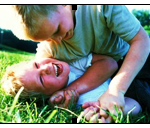 Last week at an early childhood development conference in Squamish, B.C., I had the pleasure of listening to a deeply thoughtful and engaging keynote address given by Barry Macdonald. An experienced educator, school counsellor and clinical counsellor, Barry champions the proper understanding of boys, and challenges the ways schools interpret and deal with their behaviours. His thoughts made me reflect on my own observations with what works and does not work for boys in the classroom and in schools in general.
Last week at an early childhood development conference in Squamish, B.C., I had the pleasure of listening to a deeply thoughtful and engaging keynote address given by Barry Macdonald. An experienced educator, school counsellor and clinical counsellor, Barry champions the proper understanding of boys, and challenges the ways schools interpret and deal with their behaviours. His thoughts made me reflect on my own observations with what works and does not work for boys in the classroom and in schools in general.
The Boy Code – Research shows that boys are socialized to adhere to a strict ‘boy code’ beginning as early as infancy.[1][2] This code celebrates toughness and bravery, and scorns displays of emotional vulnerability. Anger is one of the few emotions many boys feel safe showing. Female teachers in particular are prone to misreading this anger. Unfamiliar with the harsh reality of the boy code, they often take an outburst of anger at face value, interpreting it as a challenge to their authority, and failing to see the hurt and sadness that lies beneath. Once made aware of this, teachers often begin to understand their boys’ ‘misbehaviours’ in a much more tolerant, compassionate light.
Physicality and Social Development in Boys – Few things are more frustrating and difficult to come to grips with for schools than the tendency in boys towards rough play. Zero-tolerance policies abound, outlawing activities from throwing snow to ‘hands-on’ games of any kind, e.g. tag. Yet research indicates that rough-and-tumble play is one of the key ways boys develop social competencies.[3] It is one way boys express care, fondness, and friendship towards each other.[4] As Barry Macdonald rightly points out, schools could go much further towards accommodating this. “Rather than pathologize rambunctious play or playground rumble as bullying, we need to become more responsive and provide opportunities for boys to express themselves in the many and varied ways they are capable of. Rather than outlaw snowball throwing, for example, we need to provide rules and supervision, teaching our boys how to throw snow in a manner that keeps everyone safe.”[5]
Separating the Deed from the Doer – Teachers are often exasperated by the way in which boys dig in and shut down when confronted about problem behaviours. Unaware of the negative character evaluation they may be conveying, they fail to appreciate boys’ needs to protect their self-worth and avoid shame. An effective way around this, I find, is to externalize the problem. I help boys place the blame on a ‘bully dragon’, or some other entity outside them that can be battled against. I may say, “So it sounds like your bully dragon got control of the situation today, huh?” Or, on a good day when no problems arose, I may ask, “So what did you did to fight off the dragon at school today? You didn’t let it beat you – what tricks did you use?” Celebrating these successes develops feelings of competency and control in boys, feelings that are desperately needed for those who struggle with powerlessness and low self-worth.
The author wishes to make clear that the views expressed above are his alone, and do not necessarily reflect those of the C.C.P.A., its members, or affiliates.
Adrian Juric is a District Elementary Counsellor for School District #48 in Squamish, B.C. He works with students at five different elementary schools each week. Before becoming a school counsellor, he spent thirteen years teaching in private schools in Finland, Ecuador, Singapore, and Egypt. Adrian is an ardent reader, kayaker, and fan of anything Ken Robinson or David Whyte has to say. His agrees strongly with Rabbi Schmuley’s belief that ‘school counselors bring kids out of darkness into the light, out of career into calling, out of doing into being’.
[1] Grieshaber, Susan. ‘Constructing the Gendered Infant.’ In Gender in Early Childhood. Yelland, Nicola (Ed.); pp. 15-35. Florence, KY, US: Taylor & Frances/Routledge, 1998.
[2] Adler, Patricia A., Kless, Steven J., Adler, Peter. “Socialization to Gender Roles: Popularity Among Elementary School Boys and Girls.” Sociology of Education, Vol 65(3), 1992. pp. 169-187.
[3] Pellegrini, A. D. “Elementary school children’s rough-and-tumble play.” Early Childhood Research Quarterly, 4(2), 1989. pp. 245-260.
[4] Reed, Tom; Brown, Mac. “The Expression of Care in the Rough and Tumble Play of Boys.” Journal of Research in Childhood Education, 15(1), 2001. pp. 104-116
[5] Macdonald, Barry. (2005). Boy Smarts: Mentoring Boys for Success at School. Surrey, B.C.: Mentoring Press, p.57.
*The views expressed by our authors are personal opinions and do not necessarily reflect the views of the CCPA